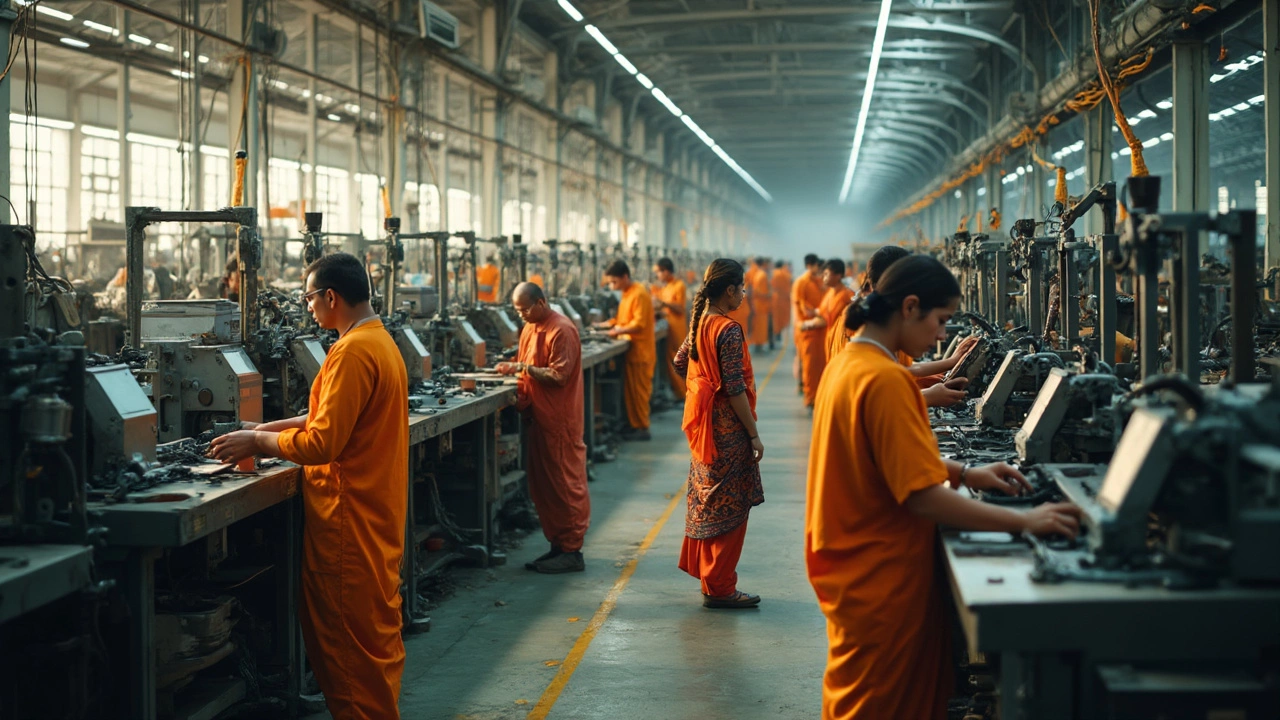Three Pillars of Manufacturing: What Actually Drives Success?

Factories aren’t magic. Every product on your desk or in your kitchen is the end result of careful planning, lots of machines, and a whole lot of teamwork. The secret? Three main pillars keep things running smoothly: production systems, quality control, and efficiency. Miss out on any of these, and things fall apart quickly—wasted resources, unhappy customers, and red ink in the balance sheets.
Think about it like building a house. If the foundation is weak or if you forget the walls, the roof won’t stay up. Manufacturing works the same way, just with more moving parts. The smartest companies and even the newest government schemes in countries like India are all built around these three ideas, making sure that what gets made is fast, reliable, and up to the mark.
If you’re curious about how this actually plays out on the factory floor—or what the government is doing to push Indian manufacturing higher than ever—you’re in the right place. Let’s break down what these pillars mean, why they matter, and how they connect in the real world.
- The Foundation: Production Systems
- Pillar Two: Quality Control and Assurance
- Efficiency: The Engine That Never Sleeps
- How Government Schemes Support the Three Pillars
- Tips for Building a Strong Manufacturing Base
The Foundation: Production Systems
If you ask anyone who works in a factory, they’ll tell you: nothing gets made without solid production systems. This is the heart of manufacturing pillars. Think of production systems like a game plan for making stuff—whether that's cars, wires, or mobile phone parts. It covers how raw materials come in, how they move from one machine to another, and how the final product rolls out the door.
India, for example, has ramped up its game. Fact: The country jumped from being the sixth to the third-largest producer of steel worldwide in just ten years. That wasn’t an accident—it happened because of better production systems and serious investment in automation and process control.
There are a few classic models you’ll hear about on the shop floor:
- Mass production: Good for churning out huge numbers of the same product, like the cars you see on every main road.
- Batch production: Works when companies need small runs of similar products—think different biscuit flavors.
- Continuous production: Factories that never shut down, like oil refineries or cement plants, work this way.
Each has its own pros and cons. Batch is flexible, mass is cost-effective when you want big numbers, and continuous production keeps things moving 24/7, which is great for non-stop industries.
Curious how these production types actually stack up in India right now? Check out this comparison:
| Production System | Common Use in India | Main Advantage |
|---|---|---|
| Mass Production | Automobiles, Appliances | Low cost per unit |
| Batch Production | Food Processing, Textiles | Flexibility for market trends |
| Continuous Production | Steel, Cement, Oil | Consistent supply, high volume |
Modern production in India isn’t about muscle power or guesswork. Over 43% of organized manufacturing now relies on smart automation such as robots and programmable logic controllers. Government schemes like the Production Linked Incentive (PLI) program are nudging factories to skip old habits and get smarter every year. This means more jobs, less waste, and higher-quality stuff at the end of the line.
One quick tip: If you run a small manufacturing unit or plan to start one, study the best production system for what you want to make. The setup you choose can decide if your business survives or fizzles out in today’s competitive world.
Pillar Two: Quality Control and Assurance
Cutting corners in quality is a sure-shot way for any factory to burn up money fast. One product fails, and suddenly you’re buried under a pile of returns, bad reviews, and trust issues. So what actually keeps products up to the mark? It’s quality control—every step from raw materials to packaging gets a close check.
Factories in India that stand out grab hold of this pillar tightly. Many have ISO 9001 certification, which basically means they have a system to stick to quality rules every single day. No room for “chalta hai” attitude. For electronics or auto parts, it’s not unusual to see final products going through dozens of tests—think drop tests, heat tests, and repeated stress checks—before anything gets shipped out the door.
Quality control doesn’t mean a one-time check at the end. It’s built into the process with regular audits, random sampling, and training workers to spot mistakes early. Noticed how some government schemes, like the “Make in India” initiative, actually mandate some of these standards? That’s not just for show—it’s to keep Indian products competitive worldwide.
Here’s how smart factories handle quality:
- Inspect raw materials before they even get used.
- Give workers a checklist of what to watch out for on the assembly line.
- Double-check finished goods with measurement tools and sensors.
- Collect feedback from customers to catch any issues missed earlier.
The strongest factories use digital monitoring and AI scans these days—sometimes, a machine spots flaws the human eye can’t even see. At the end of the day, focusing on quality control isn’t optional anymore; it’s what separates the brands you trust from the stuff you avoid.

Efficiency: The Engine That Never Sleeps
Efficiency isn’t just a buzzword people throw around in meetings—it's what turns a normal factory into a powerhouse. When operations run efficiently, you use fewer resources, waste less material, and deliver products faster. Simply put, efficiency shaves off every little hassle and cost that can sneak into the system, and it keeps the business strong in a super competitive market.
Here’s a real-life example: Over the last few years, plenty of Indian factories have started using digital tools and automation to track how machines are doing. One popular method is called “lean manufacturing,” which is all about ditching steps that don’t add value. For instance, some auto parts plants use sensors that flag breakdowns before they even happen—so repairs happen quicker, downtime is less, and output stays smooth.
If you look at government schemes like Production Linked Incentive (PLI), you’ll see a focus on investing in new technologies and smarter processes. This isn’t just about bigger machines. It’s about training staff, getting equipment to talk to each other through IoT (Internet of Things), and running data reports to spot even tiny slowdowns. All of this boils down to better manufacturing pillars—which means goods are made cheaper, better, and faster than before.
- Automate repetitive tasks so humans can handle work that really requires skill or judgment.
- Use checklists and visual dashboards in the workspace—the pros swear by this for avoiding slip-ups or missed deadlines.
- Go digital where you can. Indian electronics factories that put in automated inspections report up to 30% higher accuracy compared to manual checks.
- Never skip on training. New machines and processes need workers who know exactly how to run them without trial-and-error wasting time.
If there’s one thing to remember, it's that efficiency is not a finish line. It’s about always asking: how can we do this better and with less waste? That’s why it’s called the engine that never sleeps.
How Government Schemes Support the Three Pillars
India’s push to become a global manufacturing hub isn’t just about factories making more stuff. It’s built on the real backbone of manufacturing: solid production systems, tight quality control, and fierce efficiency. The government isn’t just watching from the sidelines—there are concrete schemes that shove these pillars forward.
Take the Production Linked Incentive (PLI) scheme as a prime example. This one gives money, perks, or tax breaks directly to companies that hit tough production goals. That’s not pocket change—over ₹1.97 lakh crore has been earmarked across sectors like electronics, auto, and pharma since 2020. So, the PLI doesn’t just spur companies to make more; it forces them to upgrade machines and boost output without losing sight of quality or burning cash on wasteful processes. In short, all three pillars get a push.
Now, for quality control, there’s the Zero Defect Zero Effect (ZED) Certification. This isn’t just a fancy certificate for the wall. Through ZED, companies—especially the MSMEs—get training, audits, and tech upgrades, paid partly by the government. The idea? Help manufacturers create products that are top-notch (defect-free) and don't trash the environment (zero effect). It’s more than a badge. It’s access to new markets, and buyers start taking you seriously.
Efficiency is where big schemes like “Make in India” and the “Samarth Udyog Bharat 4.0” (Smart Advanced Manufacturing and Rapid Transformation Hub) come in. “Make in India” is everywhere—think branding, new industrial corridors, cutting down red tape—but Samarth Udyog throws in smart tech like IoT, AI, and robotics. The aim is clear: take small and mid-sized manufacturers, help them digitize, and drive costs down while speeding things up.
If you’re a manufacturer, tapping into these government schemes isn’t just about getting handouts. It’s about staying ahead. The right scheme can mean a new line of machines or access to expert advice you never could’ve afforded on your own. That’s why staying plugged into what’s available matters. The three pillars of manufacturing pillars aren’t theory in India—they’re baked into every scheme that's come out in the past few years.
- Check scheme eligibility regularly—policies keep changing.
- Don’t ignore quality improvement funding; there are grants for ISO and ZED certifications.
- Automate wherever possible—Samarth Udyog gives access to technology test beds for free trials!
- Talk to your state’s industry department. Some schemes are local, with extra perks.
When these schemes end up in the real world, you get factories that are faster, products that last longer, and costs that don’t spiral out of control. That’s how government steps in—not by running the machines, but by making sure the right bones are in place from day one.

Tips for Building a Strong Manufacturing Base
Getting manufacturing right isn’t just for the big-time players—anyone can level up if they focus on the basics and learn from the experts. Here are some practical things top-performing factories and even government programs in India swear by:
- Train your people regularly. In Indian manufacturing, those who invest in training see up to 22% less rework and fewer breakdowns. Skilled workers mean fewer surprises, less waste, and faster problem-solving.
- Embrace automation, but do it smartly. You don’t need robots everywhere. Even basic automation like conveyor belts or barcode scanners can cut down manual errors by over 30%, and they’re easy to set up.
- Stick to proven production systems. Systems like Lean or Six Sigma are not just jargon—they keep things organized and help everyone focus on what needs fixing, not just what’s urgent.
- Don’t skip quality checks. Use simple tools like checklists, visual displays, or IoT sensors. Factories using quality control tech report about 15% fewer customer complaints, according to 2024 data from the Indian Ministry of Heavy Industries.
- Leverage government schemes smarter. Platforms like “Production Linked Incentive (PLI)” and MSME-support programs offer tax breaks, easy loans, and even guidance on export markets. It’s free help—why skip that?
- Constantly monitor energy use and machine downtime. Even a 5% cut in energy waste has huge payoffs, and some Indian plants shave lakhs off their bills just by tracking and tweaking usage every month.
Here’s a quick look at some numbers from the Indian manufacturing world that back these strategies:
| Action | Typical Improvement (2024 data) |
|---|---|
| Worker Training | Up to 22% drop in rework/errors |
| Adopting Automation | 30% reduction in manual mistakes |
| Quality Control Tech | 15% fewer customer complaints |
| Energy Optimization | 5%+ saving on power costs |
Any company can start here—no fancy gear or massive budgets needed. If you build habits around these tips and get your basics right, your manufacturing pillars will be a lot more solid than the competition’s, and you’ll see it in your bottom line.





